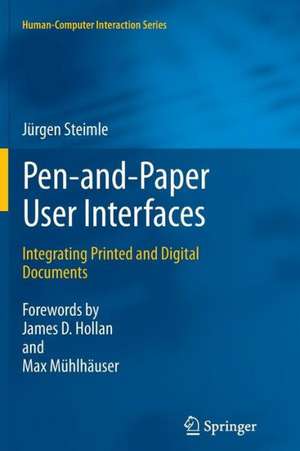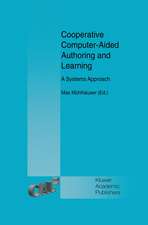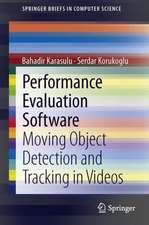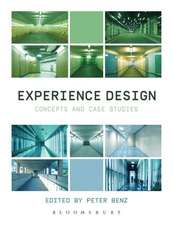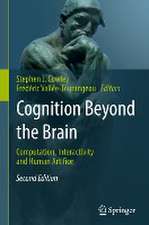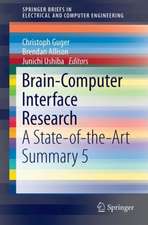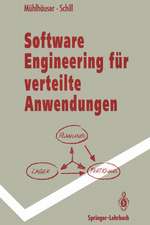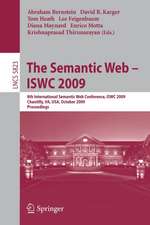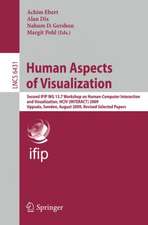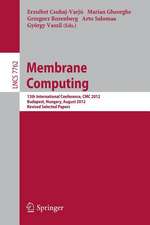Pen-and-Paper User Interfaces: Integrating Printed and Digital Documents: Human–Computer Interaction Series
Autor Jürgen Steimle Cuvânt înainte de Max Mühlhäuser, James D. Hollanen Limba Engleză Paperback – 22 feb 2014
This book provides readers with a broad and extensive overview of the field, so as to provide a full and up-to-date picture of pen-and-paper computing. It covers the underlying technologies, reviews the variety of modern interface concepts and discusses future directions of pen-and-paper computing. Based on the author’s award-winning dissertation, the book also provides the first theoretical interaction model of pen-and-paper user interfaces and an integrated set of interaction techniques for knowledge workers. The model proposes a ‘construction set’ of core interactions that are helpful in designing solutions that address the diversity of pen-and-paper environments. The interaction techniques, concrete instantiations of the model, provide innovative support for working with printed and digital documents. They integrate well-established paper-based practices with concepts derived from hypertext and social media.
Researchers, practitioners who are considering deploying pen-and-paper user interfaces in real-world projects, and interested readers from other research disciplines will find the book an invaluable reference source. Also, it provides an introduction to pen-and-paper computing for the academic curriculum.
The present book was overdue: a thorough, concise, and well-organized compendium of marriages between paper-based and electronic documents.
Max Mühlhäuser, Technische UniversitätDarmstadt
Everyone interested in how to design for real-world activities would profit from reading this book.
James D. Hollan, University of California, San Diego
| Toate formatele și edițiile | Preț | Express |
|---|---|---|
| Paperback (1) | 636.12 lei 6-8 săpt. | |
| Springer Berlin, Heidelberg – 22 feb 2014 | 636.12 lei 6-8 săpt. | |
| Hardback (1) | 640.88 lei 6-8 săpt. | |
| Springer Berlin, Heidelberg – 5 ian 2012 | 640.88 lei 6-8 săpt. |
Din seria Human–Computer Interaction Series
- 20%
 Preț: 664.44 lei
Preț: 664.44 lei - 20%
 Preț: 375.54 lei
Preț: 375.54 lei - 20%
 Preț: 817.55 lei
Preț: 817.55 lei - 20%
 Preț: 822.51 lei
Preț: 822.51 lei - 20%
 Preț: 667.75 lei
Preț: 667.75 lei - 20%
 Preț: 938.66 lei
Preț: 938.66 lei - 20%
 Preț: 991.60 lei
Preț: 991.60 lei - 20%
 Preț: 655.85 lei
Preț: 655.85 lei - 20%
 Preț: 657.16 lei
Preț: 657.16 lei - 20%
 Preț: 645.31 lei
Preț: 645.31 lei - 20%
 Preț: 994.26 lei
Preț: 994.26 lei - 15%
 Preț: 658.05 lei
Preț: 658.05 lei - 20%
 Preț: 654.21 lei
Preț: 654.21 lei - 20%
 Preț: 644.48 lei
Preț: 644.48 lei - 20%
 Preț: 1621.89 lei
Preț: 1621.89 lei - 20%
 Preț: 309.25 lei
Preț: 309.25 lei - 20%
 Preț: 1175.42 lei
Preț: 1175.42 lei - 20%
 Preț: 659.97 lei
Preț: 659.97 lei - 20%
 Preț: 219.15 lei
Preț: 219.15 lei - 20%
 Preț: 334.86 lei
Preț: 334.86 lei - 20%
 Preț: 969.84 lei
Preț: 969.84 lei - 20%
 Preț: 642.19 lei
Preț: 642.19 lei - 20%
 Preț: 314.39 lei
Preț: 314.39 lei - 20%
 Preț: 661.14 lei
Preț: 661.14 lei - 20%
 Preț: 995.89 lei
Preț: 995.89 lei - 20%
 Preț: 752.58 lei
Preț: 752.58 lei - 20%
 Preț: 990.30 lei
Preț: 990.30 lei - 20%
 Preț: 990.12 lei
Preț: 990.12 lei - 20%
 Preț: 336.21 lei
Preț: 336.21 lei - 20%
 Preț: 334.71 lei
Preț: 334.71 lei - 20%
 Preț: 312.62 lei
Preț: 312.62 lei - 20%
 Preț: 994.92 lei
Preț: 994.92 lei - 20%
 Preț: 331.74 lei
Preț: 331.74 lei - 20%
 Preț: 646.80 lei
Preț: 646.80 lei - 20%
 Preț: 994.40 lei
Preț: 994.40 lei - 20%
 Preț: 334.86 lei
Preț: 334.86 lei - 20%
 Preț: 329.76 lei
Preț: 329.76 lei - 20%
 Preț: 332.24 lei
Preț: 332.24 lei - 20%
 Preț: 992.11 lei
Preț: 992.11 lei - 20%
 Preț: 650.40 lei
Preț: 650.40 lei - 20%
 Preț: 337.00 lei
Preț: 337.00 lei - 20%
 Preț: 332.39 lei
Preț: 332.39 lei - 20%
 Preț: 1279.86 lei
Preț: 1279.86 lei - 20%
 Preț: 336.67 lei
Preț: 336.67 lei - 20%
 Preț: 1000.70 lei
Preț: 1000.70 lei - 20%
 Preț: 645.14 lei
Preț: 645.14 lei - 20%
 Preț: 646.80 lei
Preț: 646.80 lei - 20%
 Preț: 656.03 lei
Preț: 656.03 lei
Preț: 636.12 lei
Preț vechi: 748.38 lei
-15% Nou
Puncte Express: 954
Preț estimativ în valută:
121.73€ • 126.32$ • 101.75£
121.73€ • 126.32$ • 101.75£
Carte tipărită la comandă
Livrare economică 17-31 martie
Preluare comenzi: 021 569.72.76
Specificații
ISBN-13: 9783642427336
ISBN-10: 3642427332
Pagini: 204
Ilustrații: XII, 192 p.
Dimensiuni: 155 x 235 x 11 mm
Greutate: 0.3 kg
Ediția:2012
Editura: Springer Berlin, Heidelberg
Colecția Springer
Seria Human–Computer Interaction Series
Locul publicării:Berlin, Heidelberg, Germany
ISBN-10: 3642427332
Pagini: 204
Ilustrații: XII, 192 p.
Dimensiuni: 155 x 235 x 11 mm
Greutate: 0.3 kg
Ediția:2012
Editura: Springer Berlin, Heidelberg
Colecția Springer
Seria Human–Computer Interaction Series
Locul publicării:Berlin, Heidelberg, Germany
Public țintă
ResearchCuprins
1.Introduction.- 2.-Survey of Pen-and-Paper Computing.- 3.Interaction Model of Pen-and-Paper User Interfaces.- 4.Collaborative Cross-media Annotation of Documents.- 5.Hyperlinking between Printed and Digital Documents.- 6.Paper-based Tagging of Documents.- 7.Conclusions.- References.- Index.
Textul de pe ultima copertă
Even at the beginning of the 21st century, we are far from becoming paperless. Pen and paper is still the only truly ubiquitous information processing technology. Pen-and-paper user interfaces bridge the gap between paper and the digital world. Rather than replacing paper with electronic media, they seamlessly integrate both worlds in a hybrid user interface. Classical paper documents become interactive. This opens up a huge field of novel computer applications at our workplaces and in our homes.
This book provides readers with a broad and extensive overview of the field, so as to provide a full and up-to-date picture of pen-and-paper computing. It covers the underlying technologies, reviews the variety of modern interface concepts and discusses future directions of pen-and-paper computing. Based on the author’s award-winning dissertation, the book also provides the first theoretical interaction model of pen-and-paper user interfaces and an integrated set of interaction techniques for knowledge workers. The model proposes a ‘construction set’ of core interactions that are helpful in designing solutions that address the diversity of pen-and-paper environments. The interaction techniques, concrete instantiations of the model, provide innovative support for working with printed and digital documents. They integrate well-established paper-based practices with concepts derived from hypertext and social media.
Researchers, practitioners who are considering deploying pen-and-paper user interfaces in real-world projects, and interested readers from other research disciplines will find the book an invaluable reference source. Also, it provides an introduction to pen-and-paper computing for the academic curriculum.
The present book was overdue: a thorough, concise, and well-organized compendium of marriages between paper-based and electronic documents.
Max Mühlhäuser, Technische Universität Darmstadt
Everyoneinterested in how to design for real-world activities would profit from reading this book.
James D. Hollan, University of California, San Diego
This book provides readers with a broad and extensive overview of the field, so as to provide a full and up-to-date picture of pen-and-paper computing. It covers the underlying technologies, reviews the variety of modern interface concepts and discusses future directions of pen-and-paper computing. Based on the author’s award-winning dissertation, the book also provides the first theoretical interaction model of pen-and-paper user interfaces and an integrated set of interaction techniques for knowledge workers. The model proposes a ‘construction set’ of core interactions that are helpful in designing solutions that address the diversity of pen-and-paper environments. The interaction techniques, concrete instantiations of the model, provide innovative support for working with printed and digital documents. They integrate well-established paper-based practices with concepts derived from hypertext and social media.
Researchers, practitioners who are considering deploying pen-and-paper user interfaces in real-world projects, and interested readers from other research disciplines will find the book an invaluable reference source. Also, it provides an introduction to pen-and-paper computing for the academic curriculum.
The present book was overdue: a thorough, concise, and well-organized compendium of marriages between paper-based and electronic documents.
Max Mühlhäuser, Technische Universität Darmstadt
Everyoneinterested in how to design for real-world activities would profit from reading this book.
James D. Hollan, University of California, San Diego
Caracteristici
First book in this field A well-motivated introduction to the field of paper-based user interfaces Color figures included Includes supplementary material: sn.pub/extras
